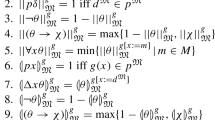Abstract
The first mention of the concept of an inconsistency measure for sets of formulas in first-order logic was given in 1978, but that paper presented only classifications for them. The first actual inconsistency measure with a numerical value was given in 2002 for sets of formulas in propositional logic. Since that time, researchers in logic and AI have developed a substantial theory of inconsistency measures. While this is an interesting topic from the point of view of logic, an important motivation for this work is also that some intelligent systems may encounter inconsistencies in their operation. This research deals primarily with propositional knowledge bases, that is, finite sets of propositional logic formulas. The goal of this paper is to extend the concept of inconsistency measure in a formal way to sets of formulas with the modal operators “necessarily” and “possibly” applied to propositional logic formulas. We use frames for the semantics, but in a way that is different from the way that frames are commonly used in modal logics, in order to facilitate measuring inconsistency. As a set of formulas may have different inconsistency measures for different frames, we define the concept of a standard frame that can be used for all finite sets of formulas in the language. We do this for two languages. The first language, AMPL, contains formulas where a prefix of operators is applied to a propositional logic formula. The second language, CMPL, adds connectives that can be applied to AMPL formulas in a limited way. We show how to extend propositional logic inconsistency measures to such sets of formulas. Finally, we define a new concept, weak inconsistency measure, and show how to compute it.
Similar content being viewed by others
References
Besnard, Ph., and J. Grant, Relative inconsistency measures, Artificial Intelligence 280:103231, 2020.
Blackburn, P., M. de Rijke, and Y. Venema, Modal Logic, Cambridge University Press, 2001.
DeBona, G., J. Grant, A. Hunter, and S. Konieczny, Classifying inconsistency measures using graphs, Journal of Artificial Intelligence Research 66:937–987, 2019.
Grant, J., Classifications for inconsistent theories, Notre Dame Journal of Formal Logic XIX:435–444, 1978.
Knight, K. M., Measuring inconsistency, Journal of Philosophical Logic 31:77–98, 2002.
Priest, G., The logic of paradox, Journal of Philosophical Logic 8:219–241, 1979.
Thimm, M., On the evaluation of inconsistency measures, in J. Grant and M. V. Martinez (eds.), Measuring Inconsistency in Information, College Publications, 2018, pp. 169–194.
Acknowledgements
I wish to thank the reviewers for very helpful comments.
Author information
Authors and Affiliations
Corresponding author
Additional information
In Memoriam Bolesław Sobociński (1906–1980)
Publisher's Note
Springer Nature remains neutral with regard to jurisdictional claims in published maps and institutional affiliations.
I am grateful to Professor Sobociński, who as the Editor-In-Chief of the Notre Dame Journal of Formal Logic in the 1970s helped me publish several papers including reference [4].
Presented by Heinrich Wansing
Rights and permissions
About this article
Cite this article
Grant, J. Measuring Inconsistency in Some Logics with Modal Operators. Stud Logica 109, 581–605 (2021). https://doi.org/10.1007/s11225-020-09917-y
Received:
Published:
Issue Date:
DOI: https://doi.org/10.1007/s11225-020-09917-y




